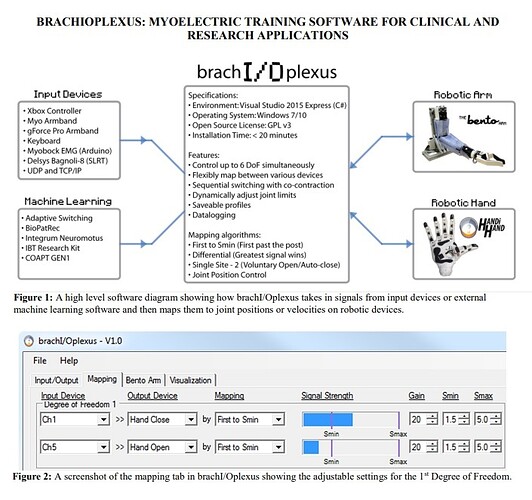Abstract
Various control strategies are now available for myoelectric devices. The selection of the most appropriate strategy for an individual patient and training to improve their skills are important components to optimize user function with their myoelectric prosthesis. Existing myoelectric training software is often limited by not providing enough features to allow prosthesis users to try the multiple options for prosthetic hands, wrists, and elbows and the various control strategies used to modulate or switch between them. To address this gap, we developed an open-source training software for clinical and research applications called brachI/Oplexus that aims to provide a wider breadth of options and also be easy to use by non-technical users. The software supports several input devices (EMG systems), output devices (robotic arms), and methods for mapping between them (conventional and machine learning controllers). A comparison was performed between brachI/Oplexus and two commercial myoelectric software programs. Results from the testing showed that brachI/Oplexus had similar or slightly improved EMG signal separation and delay when compared to the commercial software. Several research labs and hospitals are already using this software, and by releasing it open source, we hope to lower the barrier of entry and encourage other clinicians and researchers to explore this area.
Keywords:
myoelectric; training; robotic arm; powered prosthesis; electromyography; EMG; person with amputation; rehabilitation
Featured Technology: Dynamixel SDK, Dynamixel MX series
Citation:
M. R. Dawson, H. E. Williams, G. Murgatroyd, J. S. Hebert, P. M. Pilarski, “brachIOplexus: Myoelectric Training Software for Clinical and Research Applications,” Myoelectric Control Symposium (MEC), 2020. (Published Copy)
Overview Website: Overview - brachI/Oplexus
Open Source Repository: GitHub - BLINCdev/brachIOplexus: A digital nerve center for connecting human interfaces to robotic arms
